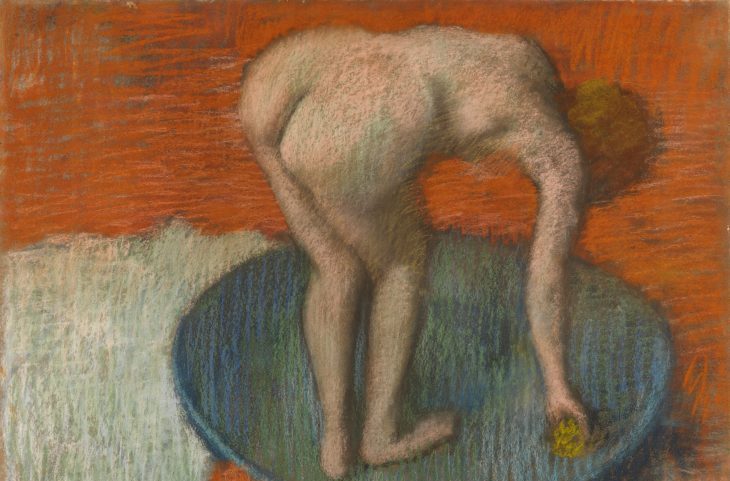Where was Degas standing as he sketched his ‘Laundresses’ (c.1882–4)? Did he watch the two women from behind sheets hanging to dry? Or was he hidden by steam from the basins? The laundry women are unselfconscious, unguarded. One reads aloud from a list, calling out shirts, collars, cuffs to be washed and ironed. Another leans over her workbench, staring into the placket of a folded shirt like Narcissus into his pool. Neither is the least bit bothered by the artist making a rapid chalk sketch to be worked up later in pastel. Nor the two men in ‘At the Café de Châteaudun’ (c.1869–71), reading a newspaper with monocle and magnifying glass. Degas might be peering at them over the top of his menu. A coffee, a croissant, a sneaking sketch.
In ‘Women in a Theatre Box’ (c.1885–90), Degas has misread his ticket and barged in on the wrong seats. The two women, mid-gossip, haven’t noticed the snoop at the back of the box. You imagine Degas sketching rapidly, eavesdropping furiously, before retreating, still not spotted by his unwitting sitters.
There is something of the paparazzo about Edgar Degas (1834–1917). ‘Click!’ goes the shutter of his eye. A fleeting moment, a snapshot, a candid close-up. He catches his subjects unaware, off-duty, yawning, fidgeting, in ungainly, in-between poses, tying a slipper lace, adjusting a pinching shoulder strap. He is master of the zoom lens, prying, spying, fascinated. ‘It is as if you looked through a keyhole,’ he said.
There is a tension in his sketches. On the one hand, the rapt intensity of his gaze. On the other, a need for rapid expression: swift chalk strokes, firework dashes of pastel, brisk scribbles of colour as in the grass background of his ‘Russian Dancers’ (1899). Quick, quick, before the ballet master calls a new pose, before the bather turns and sees him, before the foot stamps the ground and the frame is lost.
The opening image of the National Gallery’s excellent exhibition Drawn in Colour: Degas From the Burrell is a daring one. In ‘Woman Looking Through Field Glasses’ (c.1869), the hunter becomes the hunted (see p.53). Degas, that fierce looker, that nosiest of parkers, sketches in pencil and essence (paint drained of its oil and diluted with turpentine) a woman at the races. She directs her binoculars not at the jumps or the jockeys, but at the artist — and at us. She cups her elbow with her free hand and holds the glasses to her face. With her hat pulled low and the binoculars covering her eyes, we see almost nothing of her expression. She has a rare advantage. ‘You lookin’ at me?’ she seems to say, bold and unabashed.
To mark the hundredth anniversary of Degas’s death, the National Gallery has borrowed from the Burrell Collection in Glasgow to mount this inspiring display of paintings and pastels. Industrialist Sir William Burrell (1861–1958), who made his money in shipping, collected 23 works by Degas and regretted never having met the man whose oils and pastels he so admired. The ‘Woman Looking Through Field Glasses’ was the first Degas he bought.
Drawn in Colour, curated with wit and insight by Julien Domercq, tackles three themes in three rooms: ‘Modern Life’, ‘Dancers’ and ‘Privacy Observed’. It is a Goldilocks show: just the right size, not so big you are flagging, nor so small that you leave unsatisfied. The Fitzwilliam Museum’s Degas: A Passion for Perfection (3 October–14 January 2018), curated by Jane Munro — opening just too late for my deadline — is the more sweeping survey, giving us landscape, sculpture and a glass of green absinthe. There is great pleasure to be had in this autumn glut of bathers, drinkers and dancers. Could you ever be bored of Degas’s dancers, ever have seen too many tutus? No!
The Fitzwilliam catalogue trumps the National Gallery’s, so save your book shopping for Cambridge. See both exhibitions if you possibly can: a glorious Degas pas de deux.
At the National Gallery, we open with the spirit of Charles Baudelaire, whose essay ‘The Painter of Modern Life’ (1863) called on artists to paint boulevards and bistros, café dandies and come-hither courtesans. Degas takes us into that steaming laundry room with its brassy washgirls. We stand in driving rain to place our bets in ‘Jockeys in the Rain’ (c.1883–6), and jostle elbow-to-elbow with two women buying a brooch in ‘At The Jeweller’s’ (c.1887). The pastel is loose and hazy. A fine mist of colour like gold dust settles on arms, woodwork, the countertop. Degas was a master of such shimmering pastels — sfumato by the Seine. The gallery boards explaining materials and technique are particularly good.
In the second room, we leave the streets for ballet practice rooms, the barre, banquettes where the dancers from the Opéra sit and nurse their ankles. ‘The Green Ballet Skirt’ (c.1896) has you wincing as a pipsqueak-thin dancer massages the sole of one foot with her thumb. Stretch, bend, plié, ache, en pointe, ouch. How long did the ballet girls in tulle hold those arabesques in ‘The Rehearsal’ (c.1874)? Degas stands in a corner of the room, below a spiral staircase, a fly-on-the-wall observer of first positions and ballet buns. He adored the ballet, attending 54 performances in just one year in 1885, and his backstage and in-the-wings sketches convey to us some of his awe and delight in the dancers.
The third room is more unsettling. Here is Degas at his most through-the-keyhole, watching women — models? prostitutes? modern Susannahs watched by the Elders? — bathe, soap and comb their hair. As with the ‘Theatre Box’, we are intruders, we know we shouldn’t be there, we have blundered in uninvited. Degas dares you to look — and won’t let you tear your gaze away.







Comments